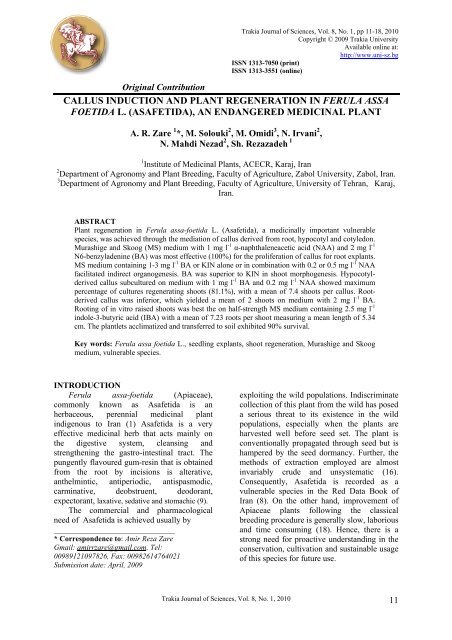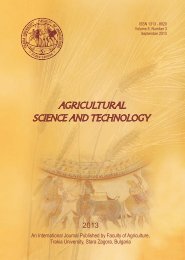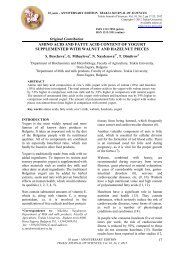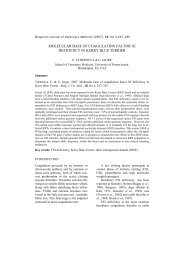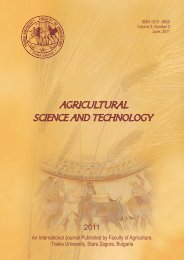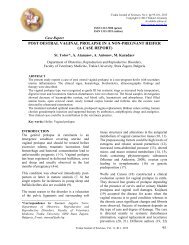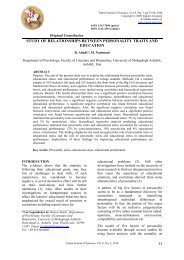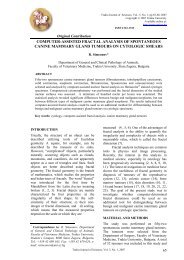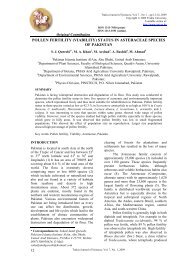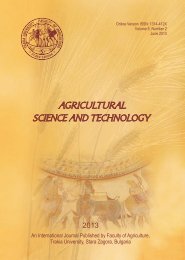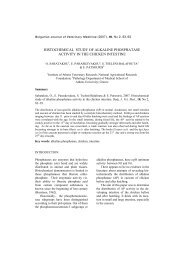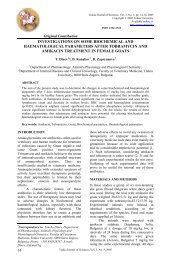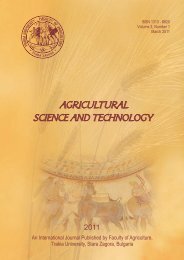callus induction and plant regeneration in ferula assa foetida l.
callus induction and plant regeneration in ferula assa foetida l.
callus induction and plant regeneration in ferula assa foetida l.
- No tags were found...
Create successful ePaper yourself
Turn your PDF publications into a flip-book with our unique Google optimized e-Paper software.
A.R. ZARE, et al.Table.1 Callus <strong><strong>in</strong>duction</strong> from different ex<strong>plant</strong>s of F. <strong>assa</strong>-<strong>foetida</strong> on MS medium with differentgrowth regulators.Growth Regulators (mg l -1 ) Callus <strong><strong>in</strong>duction</strong> (%)2,4-D NAA BAP KIN root hypocotyl cotyledonMS basal media 15 wx 0 y 0 y1 37.1 f-u 28.6 m-x 24 q-x1 1 50 d-n 50.4 d-m 39.6 f-t1 2 60.5 c-g 57.5 d-h 43.8 e-q2 45.2 e-q 26.3 o-x 18.6 u-x2 1 63.3 b-f 29.2 l-x 25.4 p-x2 2 59.6 c-g 30.4 k-w 19.2 u-x4 27.1 o-x 0y 0 y4 1 28.3 n-x 0 y 0 y4 2 23.8 t-x 16 v-x 0 y1 1 46 e-s 42.3 e-s 34.6 k-w1 2 46.8 d-p 46 e-q 33.4 h-v2 1 53.3 d-k 42.3 e-s 0 y2 2 60 c-g 37.4 f-u 31.7 j-w4 1 22.4 s-x 19.1 u-x 0 y4 2 23.6 q-x 0 y 0 y1 63.6 b-f 47.5 d-o 36.9 f-u1 1 90.2 a-c 62.4 b-f 56 d-j1 2 100 a 64 b-f 52.5 d-l2 69.6 b-e 57.7 d-h 33.1 h-w2 1 92.8 ab 63.6 b-f 43.1 e-r2 2 89.5 a-c 74.9 a-d 62.4 b-f4 57.5 d-i 27.1 o-x 24.3 q-x4 1 57.7 d-i 24.9 q-x 0 y4 2 64.6 c-g 34.8 h-v 26.5 o-x1 1 50.8 d-o 42.4 f-s 33.8 h-v1 2 54 d-k 46 e-q 40 f-s2 1 40 f-s 30 k-w 34 h-v2 2 43.1 e-r 28.2 m-x 20.9 t-x4 1 33.1 i-w 22.9 r-x 12.9 x4 2 38 g-u 29.8 l-x 18 u-xMeans followed by the same letters with<strong>in</strong> columns are not significantly different at the 5% level.RESULTThe seeds cultured on basal mediumdevoid of any <strong>plant</strong> growth regulatorgerm<strong>in</strong>ated normally, develop<strong>in</strong>g <strong>in</strong>toseedl<strong>in</strong>gs with roots <strong>and</strong> shoots without any<strong>callus</strong> formation.Root, hypocotyls <strong>and</strong> cotyledon derived from20-days-old <strong>in</strong> vitro seedl<strong>in</strong>gs cultured on MSmedium with different levels of NAA <strong>and</strong> 2,4-D either alone or <strong>in</strong> comb<strong>in</strong>ation with differentlevels of BA or KIN (Table. 1). The earliestvisible sign of <strong>callus</strong> growth from root ex<strong>plant</strong>swas noticeable between 3 <strong>and</strong> 5 days of<strong>in</strong>cubation, while <strong>callus</strong> formation oncotyledon ex<strong>plant</strong>s was observed after 3 weeksculture. In hypocotyl <strong>and</strong> cotyledon cutt<strong>in</strong>gs,<strong>callus</strong>es were formed from the basal cut end,whereas <strong>in</strong> root cultures the <strong>callus</strong>es wereproduced all over the surface of the root.Callus morphology also differed. The <strong>callus</strong>esfrom root ex<strong>plant</strong>s were white pigmented <strong>and</strong>watery with smooth surface <strong>and</strong> then turnedbrown, while <strong>callus</strong>es derived from hypocotylsegments became soft or friable, sticky,yellow-white to cream colored <strong>and</strong> nodulartype with proembryogenic structures (Fig. 1B).Cotyledon ex<strong>plant</strong>s developed nodular, green,organogenetic <strong>and</strong> compact <strong>callus</strong> (Fig. 1A).The <strong>callus</strong> became brownish after 6 weeks ofculture on medium with more than 2 mg l -1NAA or 2,4-D alone or <strong>in</strong> comb<strong>in</strong>ations withKIN, particularly the <strong>callus</strong> from root ex<strong>plant</strong>s.Trakia Journal of Sciences, Vol. 8, No. 1, 2010 13
NAA alone or <strong>in</strong> comb<strong>in</strong>ation with BA or KIN<strong>in</strong>duced shoots <strong>and</strong> roots as well as <strong>callus</strong> atvary<strong>in</strong>g frequencies depend<strong>in</strong>g on theconcentration <strong>and</strong> type of ex<strong>plant</strong>s (data notshown). Callus formation was significantly<strong>in</strong>fluenced by the ex<strong>plant</strong>s type, type <strong>and</strong>concentration of growth regulators (Table. 1).The frequency of <strong>callus</strong> <strong><strong>in</strong>duction</strong> from rootsegments was significantly higher than thatfrom hypocotyls <strong>and</strong> cotyledon segments.NAA <strong>in</strong> comb<strong>in</strong>ation with BA was mosteffective for consistent <strong>callus</strong> <strong><strong>in</strong>duction</strong>.Hence, the medium supplemented with 1mg l -1NAA <strong>and</strong> 2 mg l -1 BA was the most effectivefor the proliferation of <strong>callus</strong> from rootex<strong>plant</strong>s. Individual treatment of 2,4-D <strong>and</strong>NAA showed few response for <strong>callus</strong><strong><strong>in</strong>duction</strong>, particularly the calli from hypocotyl<strong>and</strong> cotyledon ex<strong>plant</strong>s (Table. 1).The effect of 2,4-D <strong>and</strong> NAA were quitereducible when used <strong>in</strong> higher concentration.Hence, No <strong>callus</strong> <strong><strong>in</strong>duction</strong> was obta<strong>in</strong>ed onmedium conta<strong>in</strong><strong>in</strong>g 4 mg l -1 2,4-D <strong>in</strong> hypocyylex<strong>plant</strong>s. Cotyledon segments also <strong>in</strong>cubated <strong>in</strong>the present of 4 mg l -1 2,4-D <strong>and</strong> variousconcentration of BA or KIN did not developany <strong>callus</strong>. The hypocotyl <strong>and</strong> cotyledonsegments <strong>in</strong>oculated on without growthregulators showed no <strong>callus</strong> <strong><strong>in</strong>duction</strong> (Table1).Proliferated calli of the three ex<strong>plant</strong>s,after two subcultures on the <strong>callus</strong> <strong><strong>in</strong>duction</strong>medium, were transferred to MS medium withvarious comb<strong>in</strong>ations of BA or KIN alone or <strong>in</strong>comb<strong>in</strong>ation with NAA to evaluate theirpotential for shoot formation (Fig.1D). BAproved more useful compared to KIN <strong>in</strong> shoot<strong><strong>in</strong>duction</strong> for <strong>callus</strong> produced from variousex<strong>plant</strong>s (Table 2). Shoot <strong>regeneration</strong> alsowas strongly <strong>in</strong>fluenced by the ex<strong>plant</strong>s type.Shoot <strong>regeneration</strong> was better <strong>in</strong> the <strong>callus</strong>esderived from hypocotyl as compared tocotyledon <strong>and</strong> root ex<strong>plant</strong>s (Fig.1C).Therefore, shoot production be<strong>in</strong>g <strong>and</strong> numberof shoots highest (81.1 % <strong>and</strong> 7.4 shoots per<strong>callus</strong>, respectively) when <strong>callus</strong> producedfrom hypocotyls were placed on medium with1 mg l -1 BA plus 0.2 mg l -1 NAA (Table 2).Root derived <strong>callus</strong> <strong>in</strong>duced less <strong>regeneration</strong>compared to that of other ex<strong>plant</strong>s. Therefore,<strong>callus</strong> produced from root <strong>in</strong>cubated <strong>in</strong> thepresent of 3 mg l -1 BA or k<strong>in</strong>et<strong>in</strong> <strong>and</strong> variousconcentration of NAA did not develop anyshoot (Table 2). Presence of KIN atconcentrations higher than 2 mg l -1 decreasedshoot formation. Hence, <strong>callus</strong> produced fromroot <strong>and</strong> cotyledon ex<strong>plant</strong>s <strong>in</strong>oculated on MSA.R. ZARE, et al.medium supplemented with 3 mg l -1 KN alone<strong>and</strong> or <strong>in</strong> comb<strong>in</strong>ation with either of 0.2 or 0.5mg l -1 NAA did not produce any shoot buds(Table 2).The mean number of shoots decreasedwith <strong>in</strong>crease <strong>in</strong> the concentrations of NAA(Table 2). When <strong>callus</strong> derived from differentex<strong>plant</strong>s were cultured on media conta<strong>in</strong><strong>in</strong>gBA or KIN <strong>in</strong> comb<strong>in</strong>ation with NAA, it isevident that the mean number of shoots wasclosely related to concentration of the NAAsupply. Increas<strong>in</strong>g NAA decreased thefrequency <strong>and</strong> number of shoots concomitantwith an <strong>in</strong>crease <strong>in</strong> the amount of <strong>callus</strong>(Table. 2). MS basal medium was unable toevoke shoot <strong>regeneration</strong> from root <strong>and</strong>cotyledon derived calli, while it was observedthat there was a considerable <strong>in</strong>crease <strong>in</strong> shootnumber on MS hormone free <strong>in</strong> calli producedfrom hypocotyl ex<strong>plant</strong>s.The shoots were subcultured on the samemedium <strong>and</strong> were allowed to grow till theyatta<strong>in</strong>ed height of 3 cm with<strong>in</strong> 6 weeks. Then,Individual shoots (2–3 cm) with their apicalleaves were cultured separately <strong>in</strong> half-strengthMS medium supplemented with IAA, NAA orIBA for root formation. Root <strong><strong>in</strong>duction</strong> wasobserved <strong>in</strong> all the treatments. Of the threeaux<strong>in</strong>s tested, IBA was found to becomparatively more effective than other twoaux<strong>in</strong>s NAA <strong>and</strong> IAA at differentconcentrations tested for produc<strong>in</strong>g roots(Table. 3). Among the different concentrationsused, maximum number of roots (7.23) pershoot <strong>and</strong> highest root<strong>in</strong>g (88.8%) wereobta<strong>in</strong>ed with 2.5 mg l -1 IBA with<strong>in</strong> 4 weeks <strong>in</strong>the culture medium (Fig. 1E). A further<strong>in</strong>crease of IBA <strong>and</strong> NAA concentration above2.5 mg l -1 decreased the root<strong>in</strong>g percentage,number of roots per shoot <strong>and</strong> length of theroots. Ex<strong>plant</strong>s <strong>in</strong>oculated on the entire mediagenerally <strong>in</strong>duced <strong>callus</strong> at the base of theshoots (Table. 3).Plantlets hav<strong>in</strong>g well-developed rootswere transferred to small plastic cupsconta<strong>in</strong><strong>in</strong>g s<strong>and</strong>, fertile soil <strong>and</strong> vermiculite(1:1:1) <strong>and</strong> the humidity was ma<strong>in</strong>ta<strong>in</strong>ed atapproximately 90% by cover<strong>in</strong>g with plastic(Fig. 1F). They were watered twice every 4days. About 35–40% of the <strong>plant</strong>s transferred<strong>in</strong>to soil died after one to two weeks, mostlybecause of fungal <strong>in</strong>fection. After 2 months the<strong>plant</strong>s were transferred to larger pots <strong>and</strong> afteracclimatization, the 70-day-old <strong>plant</strong>s weretransferred to field.14Trakia Journal of Sciences, Vol. 8, No. 1, 2010
A.R. ZARE, et al.Fig.1. Callus <strong><strong>in</strong>duction</strong> <strong>and</strong> <strong>plant</strong> <strong>regeneration</strong> processes of various ex<strong>plant</strong>s <strong>in</strong> Ferula <strong>assa</strong> <strong>foetida</strong>. A.Callus <strong><strong>in</strong>duction</strong> <strong>and</strong> root formation of cotyledon ex<strong>plant</strong>s on MS medium supplemented with 1 mg l -1<strong>and</strong> 2 mg l -1 BA after a culture period of 6 weeks (bar=1 cm), B. Sticky <strong>and</strong> creamy <strong>callus</strong> ofhypocotyl ex<strong>plant</strong>s on MS medium conta<strong>in</strong><strong>in</strong>g 2 mg l -1 NAA with 2 mg l -1 BA after subculture (bar=1cm), C. Initiation shoot <strong>regeneration</strong> of hypocotyl ex<strong>plant</strong>s on MS medium conta<strong>in</strong><strong>in</strong>g with 2 mg l -1BA <strong>and</strong> 0.2 mg l -1 NAA (bar=0.5 cm), D. Shoot <strong>regeneration</strong> from the hypocotyl -derived calli on MSmedium fortified with BA (1 mg l -1 ) <strong>and</strong> NAA (0.2 mg l -1 ) 5 weeks after culture (bar=1 cm), E. Root<strong><strong>in</strong>duction</strong> from multiplied shoots on half-strength MS medium supplemented with IBA (2.5 mg l -1 )after 6 week of culture (bar=1 cm), F. A healthy <strong>plant</strong> <strong>in</strong> plastic cups conta<strong>in</strong><strong>in</strong>g s<strong>and</strong>, fertile soil <strong>and</strong>vermiculite (1:1:1) (bar= 1cm).DISCUSSIONAlthough F.<strong>assa</strong> <strong>foetida</strong> is a very valuablemedic<strong>in</strong>al <strong>plant</strong>, there is no study about <strong>callus</strong><strong><strong>in</strong>duction</strong> <strong>and</strong> <strong>in</strong> vitro propagation of this <strong>plant</strong>.We, therefore, aimed to develop an <strong>in</strong> vitroculture protocol for the high-efficiency<strong>regeneration</strong> of Asafetida <strong>plant</strong> by <strong>plant</strong><strong>regeneration</strong> from <strong>callus</strong> cultures.The best frequency of germ<strong>in</strong>ation wasobserved <strong>in</strong> seeds placed at 4 ˚C for 30 days.The need for a period of cold stratification fordormancy break<strong>in</strong>g has been reported for otherApiaceae <strong>plant</strong>s (15). The chill<strong>in</strong>g treatmentenhances the maturation of the embryoelim<strong>in</strong>at<strong>in</strong>g seed dormancy (4).Trakia Journal of Sciences, Vol. 8, No. 1, 2010 15
A.R. ZARE, et al.Table.2 Shoot <strong><strong>in</strong>duction</strong> efficacy of root, hypocotyls <strong>and</strong> cotyledon-derived <strong>callus</strong> of F. <strong>assa</strong>-<strong>foetida</strong> onMS medium with different growth regulators (after 6 weeks).Growth regulators(mg l -1 ) root hypocotyl cotyledonBAP KN NAAShoots(%)No. ofshootShoots(%)No. ofshootShoots(%)No. ofshootMS basal media 0 p 0 o 24.6 g-m 2.53 h-m 0 p 0 o1 0 p 0 o 50 b-f 5 c-e 31.3 e-l 3.7 fg1 0.2 18 i-o 1.56 l-n 81.1 a 7.4 a 40 b-h 5 c - e1 0.5 10.6 o 1.33 n 60 a-c 6.2 b 30 e-l 3.3 f-j2 27.4 f-m 2 k-n 48 b-f 4.2 d-f 33 e-l 2.4 h-n2 0.2 20.7 h-n 1.43 mn 64 ab 5.2 cd 39.1 b-h 2.8 g-k2 0.5 12.3 m-o 1.4 n 52.5 a-e 5.2 cd 34 c-k 3.23 f-j3 0 p 0 o 21.2 h-n 3.5 f-g 23.5 g-m 2.4 h-n3 0.2 0 p 0 o 30.7 e-l 2.9 g-k 29.6e-l 2.53 h-m3 0.5 0 p 0 o 36.9 c-i 3.33 f-i 31.3 e-l 2.3 i-n1 0 p 0 o 33 d-l 2.03 k-n 22.4 l-o 1.5 mn1 0.2 0 p 0 o 44 b-g 3.4 f-i 35.7 c-j 2 k-n1 0.5 0 p 0 o 37 c-i 2.9 g-k 27.4 f-m 2.2 j-n2 11.93 no 1.4 n 51.7 b-f 3.7 fg 36 c-j 2.67 g-l2 0.2 16.5 j-o 1.8 k-n 57.6 a-d 4.07 ef 50 b-f 3.5 f-h2 0.5 0 p 0 o 65.1 ab 5.3 bc 34 c-k 2.77 g-k3 0 p 0 o 24 k-o 2.2 j-n 0 p 0 o3 0.2 0 p 0 o 22.4 g-m 2.37 i-n 0 p 0 o3 0.5 0 0 o 28.3 f-m 3.23 f-j 0 p 0 oMeans followed by the same letters with<strong>in</strong> a column are not significantly different us<strong>in</strong>g Duncan’sMultiple Range Test at 5% level.Table.3 In vitro root<strong>in</strong>g of shoots on half-strength MS medium fortified with different aux<strong>in</strong>s.IBA NAA IAARoot formation(%)No. ofrootsMean rootlength (cm)1/2MS basal media 22.67 e 2 f 1.26 g1 71.1 b 5.45 b-d 3.56 bc2.5 88.8 a 7.23 a 5.34 a5 63 b 4.8 ab 4.11 ab1 50 cd 3 c-e 2.57 ef2.5 63 b 4.05 a-c 3.74 b-e5 51.1 bc 3.36 cd 3.16 b-d1 38 d 2.55 e 2.3 f2.5 44 cd 3.1 de 3.12 d-f5 51.1 bc 3.27 cd 2.67 c-fMeans with<strong>in</strong> a column followed by the same (a–g) letters are not significantly different by Duncan’smultiple range test (P > 0.05).In the present <strong>in</strong>vestigation, maximum<strong>callus</strong> <strong><strong>in</strong>duction</strong> was observed from the rootex<strong>plant</strong>s <strong>in</strong> NAA/BA comb<strong>in</strong>ation. Overall,percentage of <strong>callus</strong> <strong><strong>in</strong>duction</strong> was lower forall ex<strong>plant</strong>s on media with 2,4-D plus KINwhen compared to NAA plus BA comb<strong>in</strong>ations(Table 1). These results clearly show thatNAA played a central role <strong>in</strong> the <strong>callus</strong>16Trakia Journal of Sciences, Vol. 8, No. 1, 2010
ACKNOWLEDGEMENTSThis study was supported by the Instituteof Medic<strong>in</strong>al Plants of Iran. We thank Dr.Fallah Husse<strong>in</strong>i for collect<strong>in</strong>g seeds. MscAtena Olad zad <strong>and</strong> Msc. Rahil Ashtari aregratefully acknowledged for their assistance <strong>in</strong>prepar<strong>in</strong>g this manuscript.ABBREVIATIONSMS: Murashige <strong>and</strong> Skoog; BA: N6-benzyladen<strong>in</strong>e;NAA: α-naphthaleneacetic acid; IBA: <strong>in</strong>dole-3-butyric acid; 2,4-D: 2,4- dichlorophenoxyaceticacid; KIN: k<strong>in</strong>et<strong>in</strong>;REFERENCE1. Abd El-Razek, M.H., Ohta, S., Ahmed, A.A.<strong>and</strong> Hirata, T., Sesquiterpene coumar<strong>in</strong>s fromthe roots of Ferula <strong>assa</strong> <strong>foetida</strong>.Phytochemistry, 58: 1289–1295, 2001.2. Ch<strong>and</strong>, S., Sahrawat, A.K. <strong>and</strong> Prakash, D.V.,In vitro culture of Pimp<strong>in</strong>ella anisum L.(anise). J Plant Biochem Biotech, 6: 91–95,1997.3. Ebrahimie, E., Naghavi, M.R., Hosse<strong>in</strong>zadeh,A., Behamta, M.R., Mohammadi-Dehcheshmeh, M. Sarrafi, A. <strong>and</strong>Spangenberg, G., Induction <strong>and</strong> comparison ofdifferent <strong>in</strong> vitro morphogenesis pathwaysus<strong>in</strong>g embryo of cum<strong>in</strong> (Cum<strong>in</strong>um cym<strong>in</strong>umL.) as a model material. Plant Cell, Tiss <strong>and</strong>Organ Cult., 90: 293–311, 2007.4. Goncalves, S. <strong>and</strong> Romano, A.,Micropropagation of Drosophyllumlusitanicum (Dewy p<strong>in</strong>e), an endangered WestMediterranean endemic <strong>in</strong>sectivorous <strong>plant</strong>.Biodiversity <strong>and</strong> Conservation, 14: 1071–1081,2005.5. H<strong>assa</strong>ni, B., Saboora, A., Radjabian, T. <strong>and</strong>Fallah Husse<strong>in</strong>i, H., Somatic Embryogenesis ofFerula <strong>assa</strong>-<strong>foetida</strong>. JUST, 33(4):15-23, 2008.6. He, S.S., Liu, C.Z. <strong>and</strong> Saxen, P.K., Plant<strong>regeneration</strong> of an endangered medic<strong>in</strong>al <strong>plant</strong>Hydrastis canadensis. Scientia Hortic., 113:82–86, 2007.7. Ignacimuthu, S., Arockiasamy, S.,Antonysamy, M. <strong>and</strong> Ravich<strong>and</strong>ran, P., Plant<strong>regeneration</strong> through somatic embryogenesisfrom mature leaf ex<strong>plant</strong>s of Eryngiumfoetidum, a condiment. Plant Cell Tiss. OrganCult., 56: 131–137, 1999.8. Jalili, A. <strong>and</strong> Jamzad, Z., Red Data Book ofIran. Research Institute of Forests <strong>and</strong>Rangel<strong>and</strong>s, M<strong>in</strong>istry of Jahad-e Saz<strong>and</strong>egi,657 – 669, 1999.9. Khajeh, M., Yam<strong>in</strong>i, Y., Bahramifar, N.,Sefidkon, F. <strong>and</strong> Pirmoradei, M.R.,Comparison of essential oils compositions ofFerula <strong>assa</strong>-<strong>foetida</strong> obta<strong>in</strong>ed by supercriticalcarbon dioxide extraction <strong>and</strong> hydrodistillationmethods. Food Chemistry, 91: 639–644, 2005.10. Makunga, N.P., Jager A.K. <strong>and</strong> Staden, J.V.,An improved system for the <strong>in</strong> vitroA.R. ZARE, et al.<strong>regeneration</strong> of Thapsia garganica via directorganogenesis – <strong>in</strong>fluence of aux<strong>in</strong>s <strong>and</strong>cytok<strong>in</strong><strong>in</strong>s. Plant Cell Tiss. Organ Cult., 82:271–280, 2005.11. Mart<strong>in</strong>, K. P., Rapid axillary bud proliferation<strong>and</strong> ex vitro root<strong>in</strong>g of Eupatorium tripl<strong>in</strong>erve.Biologia <strong>plant</strong>arum, 47: 589-591, 2003.12. Mart<strong>in</strong>, K. P., Efficacy of different growthregulators at different stages of somaticembryogenesis <strong>in</strong> Eeryngium foetiduml – a raremedic<strong>in</strong>al <strong>plant</strong>. In Vitro Cell. Dev. Biol.—Plant, 40: 459–463, 2004.13. Mart<strong>in</strong>, K. P., Plant <strong>regeneration</strong> throughsomatic embryogenesis <strong>in</strong> medic<strong>in</strong>allyimportant Centella asiatica L. In Vitro Cell.Dev. Biol.—Plant, 40: 586–591, 2004.14. Mart<strong>in</strong>, K.P., Rapid propagation ofHolostemma ada-kodien Schult., a raremedic<strong>in</strong>al <strong>plant</strong>, through axillary budmultiplication <strong>and</strong> <strong>in</strong>direct organogenesis.Plant Cell Rep., 21: 112–117, 2002.15. Nadjafi, F., Bannayan, M., Tabrizi, L. <strong>and</strong>Rastgoo, M., Seed germ<strong>in</strong>ation <strong>and</strong> dormancybreak<strong>in</strong>g techniques for Ferula gummosa <strong>and</strong>Teucrium polium. Journal of AridEnvironments, 64: 542–547, 2006.16. Omid Beygi, R. <strong>and</strong> Pirmoradei, M., A study ofthe effect of root diameter <strong>and</strong> <strong>in</strong>cision timeson the gum yield of medic<strong>in</strong>al- rangel<strong>and</strong>asa<strong>foetida</strong> (Ferula <strong>assa</strong>-<strong>foetida</strong> L.) <strong>plant</strong>.Iranian Journal of Natural Resources, 59: 261–269, 2006.17. Sahrawat, A.K. <strong>and</strong> Ch<strong>and</strong>, S., Somaticembryogenesis <strong>and</strong> <strong>plant</strong> <strong>regeneration</strong> fromroot segments of Psoralea corylifolia L., anendangered medic<strong>in</strong>ally important <strong>plant</strong>. InVitro Cell. Dev. Biol. Plant, 38: 33–38, 2002.18. Tawfik, A.A. <strong>and</strong> Noga, G., Cum<strong>in</strong><strong>regeneration</strong> from seedl<strong>in</strong>g derivedembryogenic <strong>callus</strong> <strong>in</strong> response to amendedk<strong>in</strong>et<strong>in</strong>. Plant Cell Tiss. Organ Cult., 69: 35–40, 2002.19. Tiwari, K.N., Sharma, N.C., Tiwari, V. <strong>and</strong>S<strong>in</strong>gh, B.D., Micropropagation of Centellaasiatica (L.), a valuable medic<strong>in</strong>al herb. PlantCell Tiss. Organ Cult., 63: 179–185, 2000.20. Uppendra, D., Sumit, M. <strong>and</strong> Meena, J.,Organogenesis, embryogenesis, <strong>and</strong> syntheticseed production <strong>in</strong> Arnebia euchroma - acritically endangered medic<strong>in</strong>al <strong>plant</strong> of theHimalaya. In Vitro Cell. Dev. Biol. Plant, 41:244-248, 2005.21. Urbanek, A., Zechmann, B. <strong>and</strong> Muller, M.,Plant <strong>regeneration</strong> via somatic embryogenesis<strong>in</strong> Styrian pumpk<strong>in</strong>: cytological <strong>and</strong>biochemical <strong>in</strong>vestigations. Plant Cell Tiss.Organ Cult., 79:329–340, 2004.22. Yucesan. B, Turker, A.U. <strong>and</strong> Gurel, E., TDZ<strong>in</strong>ducedhigh frequency <strong>plant</strong> <strong>regeneration</strong>through multiple shoot formation <strong>in</strong> witloofchicory (Cichorium <strong>in</strong>tybus L.). Plant CellTissue Organ Cult., 91: 243–250, 2007.18Trakia Journal of Sciences, Vol. 8, No. 1, 2010


